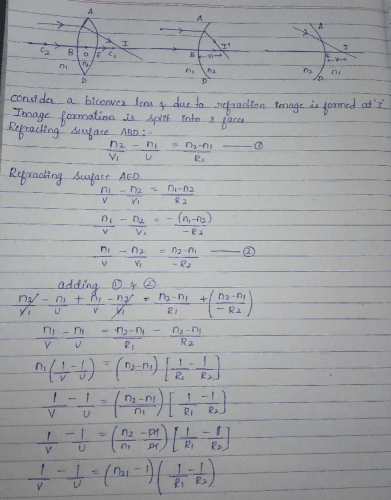Class 12 Exam > Class 12 Questions > Derive lens maker formula?
Start Learning for Free
Derive lens maker formula?
Most Upvoted Answer
Derive lens maker formula?

Community Answer
Derive lens maker formula?
Introduction
The lens maker formula is a mathematical formula that describes the relationship between the focal length, refractive index, and curvature of a lens. It is used to design lenses for various applications, including eyeglasses, telescopes, cameras, and microscopes.
Derivation
The lens maker formula is derived from the thin lens equation and the lens law. The thin lens equation is given by:
1/f = (n - 1) (1/R1 - 1/R2)
where f is the focal length, n is the refractive index of the lens material, R1 is the radius of curvature of the first lens surface, and R2 is the radius of curvature of the second lens surface. The lens law states that:
n1 sinθ1 = n2 sinθ2
where n1 and n2 are the refractive indices of the two media, and θ1 and θ2 are the angles of incidence and refraction, respectively.
Formula
The lens maker formula is given by:
1/f = (n - 1) [(1/R1) - (1/R2) + ((n - 1) d)/(n R1 R2)]
where d is the thickness of the lens.
Explanation
The lens maker formula takes into account the thickness of the lens, which is not considered in the thin lens equation. The formula shows that the focal length of a lens depends on the refractive index of the lens material, the radius of curvature of the lens surfaces, and the thickness of the lens.
The formula also shows that the curvature of the lens surfaces affects the focal length of the lens. A lens with a flatter curvature will have a longer focal length, while a lens with a steeper curvature will have a shorter focal length.
Conclusion
The lens maker formula is an important tool for designing lenses for various applications. By adjusting the refractive index, curvature, and thickness of a lens, it is possible to achieve a desired focal length and optical performance.

|
Explore Courses for Class 12 exam
|

|
Similar Class 12 Doubts
Derive lens maker formula?
Question Description
Derive lens maker formula? for Class 12 2024 is part of Class 12 preparation. The Question and answers have been prepared according to the Class 12 exam syllabus. Information about Derive lens maker formula? covers all topics & solutions for Class 12 2024 Exam. Find important definitions, questions, meanings, examples, exercises and tests below for Derive lens maker formula?.
Derive lens maker formula? for Class 12 2024 is part of Class 12 preparation. The Question and answers have been prepared according to the Class 12 exam syllabus. Information about Derive lens maker formula? covers all topics & solutions for Class 12 2024 Exam. Find important definitions, questions, meanings, examples, exercises and tests below for Derive lens maker formula?.
Solutions for Derive lens maker formula? in English & in Hindi are available as part of our courses for Class 12.
Download more important topics, notes, lectures and mock test series for Class 12 Exam by signing up for free.
Here you can find the meaning of Derive lens maker formula? defined & explained in the simplest way possible. Besides giving the explanation of
Derive lens maker formula?, a detailed solution for Derive lens maker formula? has been provided alongside types of Derive lens maker formula? theory, EduRev gives you an
ample number of questions to practice Derive lens maker formula? tests, examples and also practice Class 12 tests.

|
Explore Courses for Class 12 exam
|

|
Signup for Free!
Signup to see your scores go up within 7 days! Learn & Practice with 1000+ FREE Notes, Videos & Tests.



















